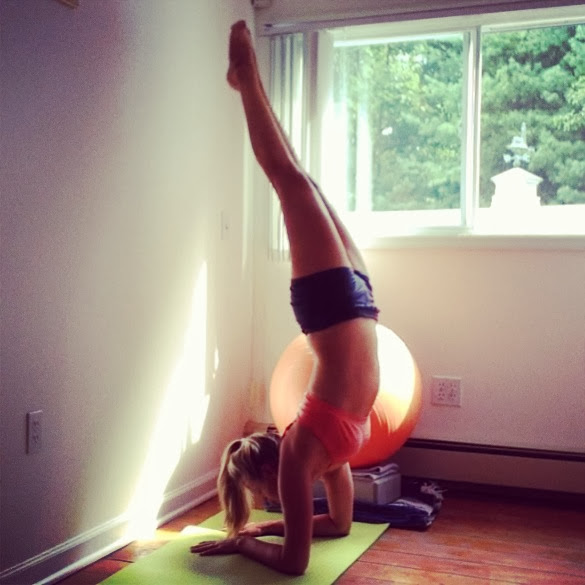Inversions have many benefits. You force yourself into meditation. To hold an inversion, you must bring your mind to a single focus- leaving no room for chitta vritti (the "monkey mind"). You'll also change the direction of gravity on your blood flow, improving circulation. Additionally, inversions help drain the lymphatic system, releasing toxins and improving your immune system. Inversions such as headstand and handstand energize the body. Others, like shoulder stand calm the nervous system. These, and many others that I haven't mentioned, are all great reasons to introduce inversions into your yoga practice, including your core routine.
I'll show you three options for inverted core work. Depending on your level, choose one that works best for you. All three will work your core in a slightly different way- so add all three if you like:
 Supported Sarvangasana-
Supported Sarvangasana-Although this is the "easiest" inversion of the three, the core work is the most intense. Grab a block (or some folded blankets), and place it under your hips. Lengthen your spine and place your hands on either side of your hips. Extend your legs straight up, ankles over knees, knees over hips. Take a long, slow inhale. On the exhale, slowly lower your straight legs to hip level. Keep your spine long by engaging the core, no arching the low back. Let the movement take as long as your slow breath. Inhale slowly here. On the exhale, lift your straight legs until your ankles stack over you hips. Repeat this motion as many times as feels good. Maybe thats 3 for you today, maybe its 30. Listen to your body. Push yourself to your edge, but not past it.
 Sarvangasana-
Sarvangasana-Lay on your back with your hands on either side of your hips. Extend your legs straight up, ankles over knees, knees over hips. Engage through the core and gently push your hands into the mat to lift your hips, the goal is to stack your hips over your shoulders. Either leave your hands on the floor for added heat or place your hands on your low back, elbows on the mat and in line with your shoulders. Take a deep inhale. On a slow exhale, lower your straight legs until your toes are an inch off the floor. Inhale. On the exhale, lift your straight legs until your ankles stack over hips, possible hips over shoulders. Repeat this motion as many times as feels good for you.
 Sirsasana-
Sirsasana-Begin in table top pose. Lower your forearms to the mat and interlace your fingers. Elbows should be shoulder distance. Place the crown of your head on the mat, with your hands gently cradling the back your head (If you don't know where the crown of your head is, stand up and balance a book on your head- where the book balances is the crown). Tuck your toes under and walk your feet in until your hips stack over your shoulders. When you get there, tuck one knee into your chest lifting your toes off the mat, then the other without any hopping (this is for the safety of your spine!). When both knees are lifted, extend your heels up so that your entire body is stacked in one line, ankles to shoulders. Engage your entire body, drawing into the midline.
You have a few choices here:
1. Take a deep inhale. Exhale, keeping your legs straight, lower your feet until they are in line with your hips. Inhale. Exhale raising your straight legs back over your head. Repeat until you hit your edge. Go very slowly and keep focus!
2. Inhale deeply. Exhale slowly bringing your knees to your chest. Inhale. Exhale straightening your legs until ankles stack over hips. Repeat as many times as feels good.
3. Take your legs into eagle pose, wrapping one leg around the other. Repeat option 2, switching the bind each time you straighten your legs towards the sky.
Try one or all three. Keep your practice at your own level. Move slowly, stay focused, and stop when you feel spent. If you're unsure of your form in any pose- ask your yoga instructor to take a look. An at home practice will vastly improve your body and mind but it isn't a replacement for attending yoga classes on a regular basis.
Book II, Sutra 46. Sthira sukhamasanam.
"Asana is a steady, comfortable posture."
I hope you enjoy these poses- namaste!


No comments:
Post a Comment